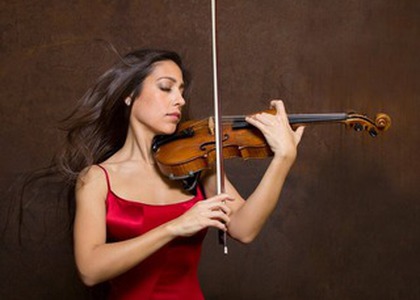> [Archived] Interviews

Interview with violinist Leticia Moreno
Leticia Moreno, you are back in Romania to perform Lalo's Symphonie espagnole together with the National Radio Orchestra. You have also performed on the stages of the Romanian Athenaeum and Banat Philharmonic of Timisoara. How did you feel when interacting with the Romanian audience?
Coming to Romania and playing music has always been a genuine pleasure and meeting such a welcoming audience was a beautiful experience. This time, I am very happy to bring on the stage of Sala Radio one of my dearest works, which I play quite often, Édouard Lalo's Symphonie espagnole.
You have held several concerts with conductor Gabriel Bebeșelea, some even on Romanian stages. How would you describe your collaboration?
It is absolutely beautiful, since we have a very clear and fluid communication and we get along really well when it comes to music, but also from a human point of view. Also, we chose the same styles of repertoire. It is wonderful to create music with friends like Gabriel Bebeșelea. So, I am looking forward to this new collaboration, especially because this piece is not among the concerts we have already held together. I cannot wait todiscover new aspects of this opus.
You are a big fan of Spanish and Latin Americanrepertoire, which you often interpret. According to you, what are the characteristics of this music and how is the violin involved in this type of repertory?
That's right, I am very fond of the Spanish and Latin American repertoires, bearing in mind the fact that I have both Spanish and Peruvian origins. I cannot generalize, but I believe that when it comes to this type of repertoire, the performer enjoys the freedom of discovering new sonorities and vibrations of the instrument. Often, composers use the violin almost like a percussion instrument. In Lalo's Symphonie espagnole, dedicated to Pablo de Sarasate, one of the greatest violinists of all time, we notice a unique kind of virtuosity, complex and very challenging for the performer. Another thing I come across, especially in Spanish pieces is the passionate and temperamental element that always has to have equilibrium in this music.
Your taste for the Spanish and Latin American repertoire can also be noticed in your recorded albums. How important do you think it is for a soloist to be present in the record market nowadays?
In my case, the choice of recording came naturally and was a big step in my career. I think my recording activity is a professionally significant part of my career, because these records are a symbol of different moments of my life, of my personal and artistic development.
Today, the public will attend a Spanish musical evening at Sala Radio. How would you describe Lalo's Symphonie espagnole from the perspective of a soloist?
As I have said, this piece was dedicated to Saraste and it is incredibly demanding, because you have to express a variety of feelings in your performance, which are very intense and passionate, combined with the elegance of phrasing and the virtuosity required by the score. The five movements of the piece are also emotionally demanding. Also, an interesting aspect regarding this piece is its designation as a symphony instead of a concerto for violin and orchestra. In this sense, I am concerned to find each of the dialogues the violin has with various instruments in the orchestra.
Translated by Cristina-Andreea Dobre,
University of Bucharest, Faculty of Foreign Languages and Literatures, MTTLC, year I
Corrected by Silvia Petrescu














